Luxury is more accessible than ever before. If anyone can have and be luxury, what does it even mean for design firms to market themselves as luxury?
I recently enrolled in a creative writing course to finesse mi español. On the first day, our teacher introduced a rule: don’t use words like “me gusta” (I like) or “lindo” (nice) because they’re too vague and imprecise.
The same is true about “luxury,” a word I hear all too often in the interior design space. Especially in the residential, retail and hospitality sectors.
As an overused word, luxury carries a slew of misconceptions, contradictions and confusion.
- Too many firms call themselves luxury … yet haven’t updated their website and portfolio since 2003.
- For some, luxury is opulence and grandeur. For others, it is sophistication and sustainability. Which one is it?!
- Many refrain from marketing altogether because they believe affluent consumers aren’t online. (That’s wrong, by the way).
It’s September and I’ve spent all summer chewing on this topic, researching and talking to peers about it. Turns out, luxury marketing is mysterious. Many firms want to position themselves as luxury but there are few resources out there on how to do it right.
Let’s explore what luxury really means, who the modern-day luxury consumer is and what it means to market yourself as a luxury brand.

What is Luxury?
How do you define luxury? When I asked our clients, their answers were so unique and nuanced.
For example, Sansa Interiors considers itself a luxury firm because of the materials and products it uses. As founder Jude Kamal explained, “Our designs revolve around using the highest-quality materials, exclusive finishes and furniture, and unique elements like custom millwork, lighting and artwork.”
In comparison, Lorla Studio defines luxury as highly personalized services and bespoke designs. Laura Hur tells us, “By spending a lot of time working with clients to understand them – who they are, what they do, how they use the space, what they love, what they hate, and what is important to them – we develop truly custom solutions and spaces for our clients.”
Many of us assume luxury is universally understood. But if these two design firms define it differently, it must be anything but universal.
Is luxury a custom-made chair and its availability? Is it the superior quality of the chair’s material? Or is it defined by the skilled people, or upholsterers, that made it?
Why is luxury hard to define? When did it become so subjective?
Let’s nerd out for a moment.
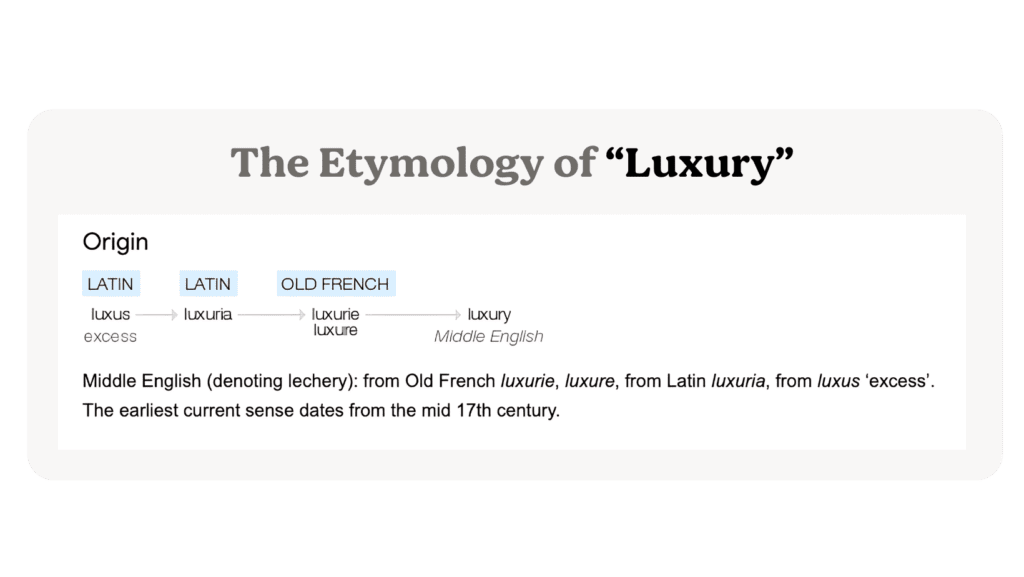
Luxury used to be reserved for aristocrats. It comes from the Latin word luxuria or luxus, which means excess. The word dates back to the 17th century when Europe’s royalty funded expeditions and indulged in the colonies’ riches. Luxury has even older roots in other languages, dating back to pharaohs and emperors.
But now, thanks to industrialization and the creation of the middle class, wealth and, therefore luxury is more accessible. But also more vague. We have many products to choose from with varying quality grades, price points and availability.
Not only are luxury products harder to define, but so are the people who buy them. Someone could purchase luxury goods and services in one product category but be frugal in another.
If anyone can have luxury, be luxury or say they are luxury, then what is luxury really? And what does it mean to call yourself a “luxury” design studio?
Frankly, I think luxury will always be a hard-to-define word. Like “sustainability” or “success”. It’s subjective because luxury products, luxury consumers and even luxury marketing practices are always evolving.
If you don’t pay attention to how luxury is evolving, you’ll be one of those firms with an outdated understanding of luxury. Let’s approach it in four stages:
- Who? Keep a pulse on the economy and who is affluent today.
- What? Understand what your affluent clients value and how they like their luxury.
- Where? Understand their behaviours and where they spend their time.
- How? Work backwards to create a marketing strategy. When you know who they are, what they want and where they are, you can create a service they want and need.
Who Are Affluent Consumers?
Luxury consumers are no longer old, male and pale.
According to the Pew Research Center (PRC), the American upper class is changing and growing.
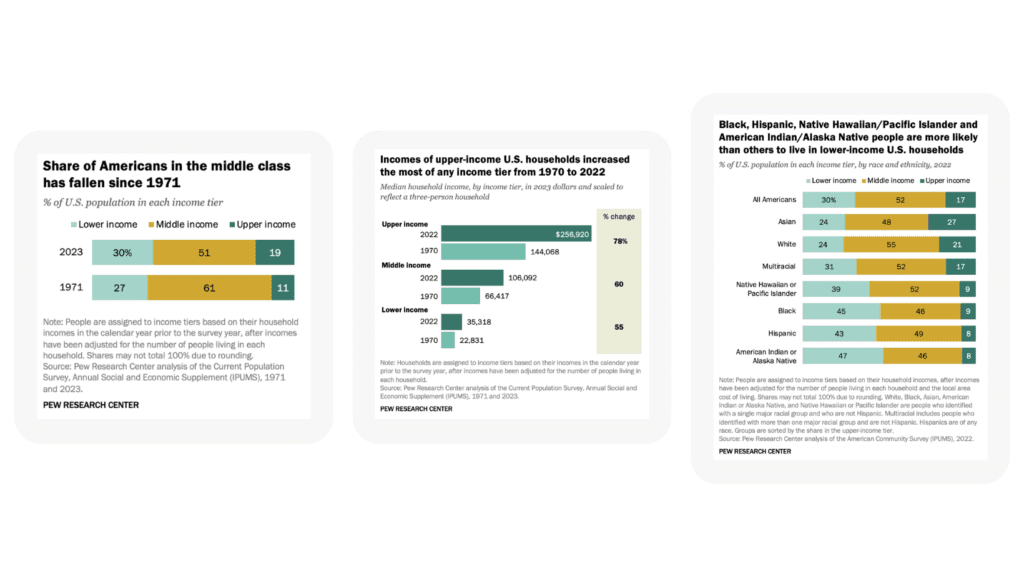
In a recent report on class trends, the PRC defined the median household income of the upper-class tier as $256,920. They’re predominantly Asian first (27%) and White second (17%). They’re also no longer Boomers. Today’s upper class comprises of Gen X – 45-64 years old (24%) and Millenials – 30-44 years old (18%)1.
In another report on wealth inequality, we know that the lower and upper classes have been increasing while the middle class is decreasing. From 1971 to 2023, the share of Americans who live in upper-income households increased from 11% to 19%2.
Business 101 says to know your target customer. As years go by, what we know as affluent consumers will evolve and so should your understanding of your target customer.
Flavour of Luxury
As the affluent consumer constantly changes, so are their values and desires. Your business isn’t just what you think luxury is – it’s an extension of what affluent consumers desire. I like to call this “flavour of luxury”.
For example, here are the four most common interpretations of the term that came up when we talked to our clients.
- Premium (i.e., best, high-quality, excellent, famous, top, expert) — A designer who’s one of the best, if not the best, at what they do.
- “The BEST shoesmith in the world makes this shoe.”
- Lavish (i.e., abundance, extravagant, grandeur, opulence, glamour) — A designer who specializes in large-scale, big-budget projects.
- “You can have as many shoes as you want.”
- Aesthetic (i.e., selective, modern, traditional, minimalist, bohemian, etc.) — A designer who understands your sense of style and taste.
- “This shoe was curated specifically for you.”
- Exclusive (i.e., elite, private, limited, custom, personal, award-winning) — A designer who works only with a select group of clients or offers concierge-level personalized customer service.
- “This shoe was made only for you.”
- “I only make shoes for you.”
This list is anything but exhaustive. Take it as a jumping-off point. As consumers and times change, so will these flavours of luxury.
Accessibility, for instance, is recently making its way into luxury’s lexicon among consumers.
By 2030, Gen Z is expected to account for 25% of luxury market purchases according to Bain & Company. This generation is more politically engaged, values diversity and disdains the status quo. And luxury brands are taking note3.
The London-based branding studio Dalziel & Pow (D&P) calls this “accessible luxury”4.
As D&P explains, brands like Gucci, Burberry and Tiffany & Co. are shaking off their stuffy, traditional approaches to luxury and adopting a more open, accessible attitude instead. They’re using words like “diverse” and “inclusive” and exemplifying it too through social media and brand vandalism campaigns, super-friendly staff in-store, and unexpected collaborations.
The takeaway? It’s not enough for you to choose words that you like. They have to be ones that your consumers are using too. If you’re not speaking the same language and flavours of luxury, the right consumers won’t connect with you. Let alone find you.
Are Luxury Clients Online?
A common myth is that affluent consumers aren’t online. We assume the wealthy are old, stuffy and only on golf courses.
The data says that’s all wrong. The modern-day luxury consumer isn’t just younger. They are also online.
Using Google Trends, the number of searches for terms like “interior designer near me” or “architect near me” has soared from 2017 to now. The same goes for “luxury interior design”5.
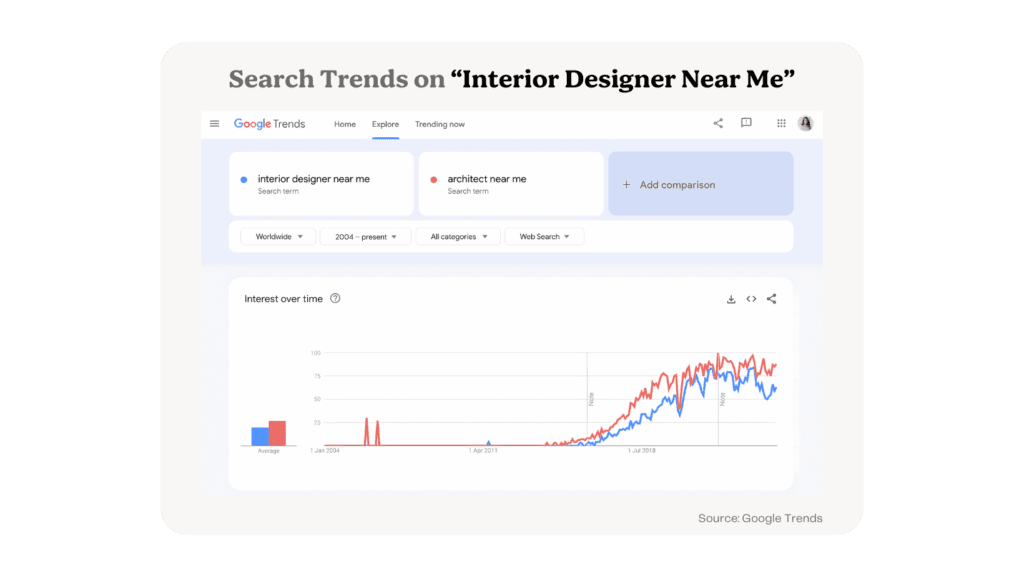
It shouldn’t come as a surprise since Gen X and Millennials look for love on dating apps and are grocery shopping online. Why wouldn’t they look for professional design services too?
Using SEMRush, they’re looking for different flavours of luxury design. In the USA alone, there are up to 1,900 monthly searches for terms like “best interior designer”, “luxury interior designer” or “modern interior designer”. The terms we use depend on how we define luxury.
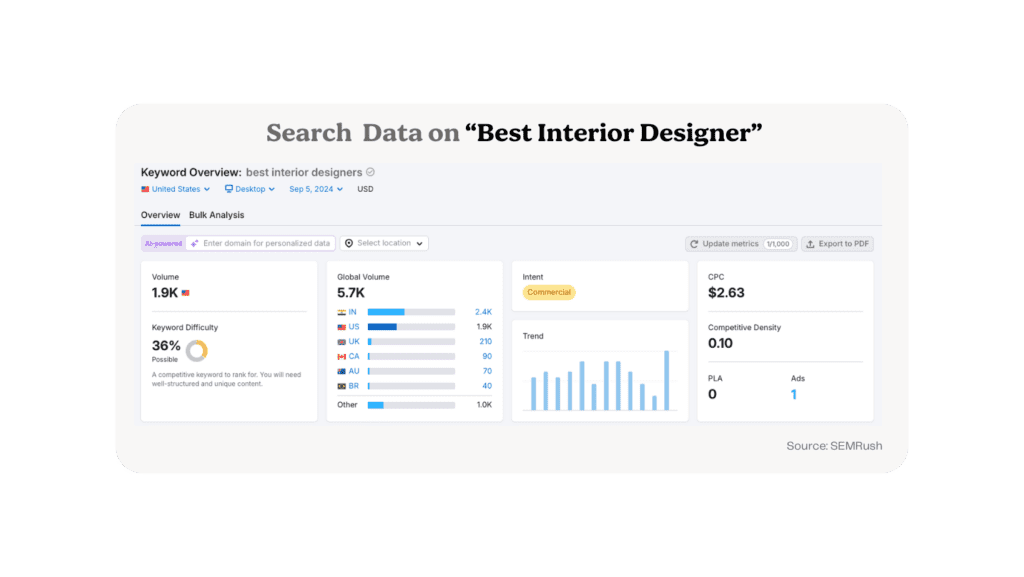
Today, 70% of luxury purchases are influenced by online interactions6, according to Bain & Company.
That means the consumer has at least one digital interaction with the brand or the product before purchasing. It doesn’t mean that consumers will hire you after a single Google search or Instagram post.
A research study published in the Journal of Marketing Management interviewed seven ultra-high-net-worth individuals (UHNWIs) and found that affluent consumers experience a privacy paradox, also known as ‘selective publicity’7.
Despite valuing privacy, UHNWIs want to stay connected through social media. What does that mean? They use social media and frequently follow luxury brands but their usage is reserved and they often use anonymous accounts to remain invisible. This is to avoid unintended social interactions and maintain privacy.
According to the study, UHNWIs use social media mainly for information gathering. One interviewee emphasized the importance of luxury brands keeping Instagram and website information consistent, as they often feel deceived when they cannot find the same product on both.
Just because affluent consumers are online, doesn’t mean they’re impulsive.
Anyone who has been in business long enough knows that luxury takes time.
The biggest clients and projects come with years of building a reputation and progressively growing your portfolio. High-end design services come with large price tags – a decision that prospective clients need time, information and trust before making. And usually, the more decision-makers there are too.
Studio McGee is an excellent example of this. She’s been landing large-scale custom home projects from her online presence for years.
In a podcast with Business of Home, she explained she couldn’t rely on word of mouth or friends and family because her network wasn’t made up of her target customers. She used social media to market herself in front of the right people and said yes to even small projects as long as they put her in the right rooms. As her reputation and portfolio grew, so did the budgets and scopes. For Studio McGee, affluent consumers found her on social media but needed time and a lot of trust to hire her for the dream projects8.
Here are some examples of how online interactions play out in the sales process:
- They see you on social media several times and eventually join your email newsletter. They follow you for months before inquiring.
- The executive assistant finds you on Google and shortlists you before passing you on to the final decision-maker.
- They heard about you through word of mouth but looked at your website or social media before inquiring.
The longer you market yourself online, the more you’ll see these examples play out in your own business. Your marketing channels start to intertwine and compound. It becomes hard to attribute a sale or business growth to one marketing channel or campaign.
The modern-day buyer journey is multi-faceted. Even more so when it’s luxury.
So, are affluent consumers online? Yes. But online isn’t the only way they learn about you and buy from you. If you want to get your name out there, you’ve got to be where they are. It’s not tacky. It’s not just for the young and broke. Don’t ignore your online presence.
What is Luxury Marketing?
No one thinks about the business of luxury more deeply than Bernard Arnault, the CEO of LVMH. As the world’s largest luxury goods company, luxury isn’t just a marketing term. It’s a way of doing business.
In an interview with Oxford Union, Arnault defines luxury as a combination of quality and creativity. Creativity, he argues, cannot be traditionally marketed9.
Here’s why:
Traditional marketing analyzes what a consumer wants and creates a product accordingly. LVMH does the opposite. They create a product first and market it afterwards. From the store environment to the commercials, LVMH puts their products in front of consumers and then gives them a reason to want it – even if they never asked for it. At LVMH, marketing luxury is to create desire.
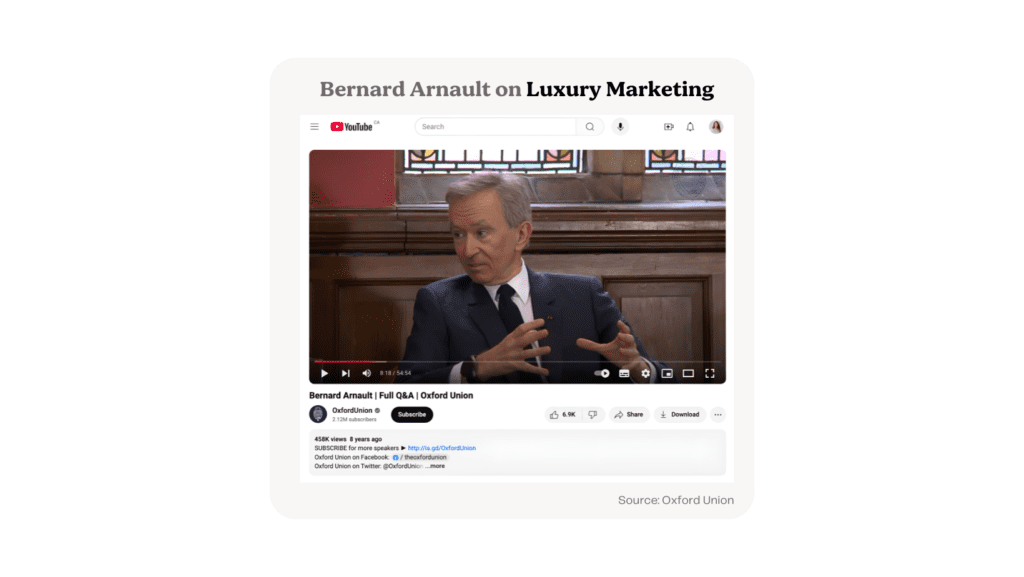
Give the interview a listen and you’ll see that luxury isn’t a word they use carelessly, like “me gusta” and “lindo.” This is a company that meticulously thinks about what luxury means to them because it informs everything they do and every decision they make.
When we’re careful about the words we use and how we market ourselves, it’s usually a symptom of being careful with our actions too. Different definitions are going to inform different marketing strategies and business practices.
Marketing Luxury Design
You may not have a physical product nor have storefronts and commercials as marketing tools like LVMH.
But you do have your body of work.
The work you’ve done up to today, market the projects you to do tomorrow. In the book, The Win Without Pitching Manifesto, author Blair Enns explains that your portfolio is your best tool of inspiration.
“[Portfolios] show the client what could be. Our examples of our best work paint the picture of the beautiful world on the other side of his pain. Inspiration is the primary role of our website, our brochure, our sales collateral and out in-person portfolio review. It need not even be our own work that we show here to inspire the interested, just inspirational outcomes.10”
It’s easy to say that you’re a luxury designer, but are you really walking the walk? Are you using your portfolio as a tool of inspiration? Do you just say your projects are luxury, or do they truly look it? Are you intentional about the projects you choose to take on? How do you photograph, write and communicate the stories behind each project?
If you’re saying you’re luxury and charging it, it’s your responsibility to be it. Both how you market your services and how you deliver them. One isn’t better than the other. They go hand in hand.
The point is this: take the time to define what luxury means to you first, then market and operate accordingly.
Don’t Just Say It, Show It
Once you’ve chosen a flavour of luxury that best aligns with what you offer, think about how you will practice what you preach in terms of how you:
- Present yourself, online
- Carry yourself, in-person
- Sell your services
- Photograph your projects
- Write about your expertise
- Execute your work
- Source materials
- Hire support
- Manage projects
- Navigate conflict
- Set your prices
As you go about this exercise, you may realize that luxury is not the best way to describe yourself. You may care more about profitability, respect from your peers or creative freedom. If so, you could build a business that fulfills all those professional needs but isn’t necessarily a luxury firm. They aren’t mutually exclusive.
For example, Kristen Weber, the Marketing Director for Chervin Kitchen & Bath, told us she’s hesitant to use the word “luxury” because their approach is best described as “premium.” “For us,” Weber explains, “premium comes down to craftsmanship as opposed to status. That influences how we present ourselves, how we talk, how our employees dress, and what our website looks like.”
Or maybe you find that you’re on a spectrum. You may be more premium in delivering your services but approachable in how you present yourself. Think of brands like Patagonia, Anthropologie or Williams Sonoma.
You Draw the Line
Luxury is a title you constantly have to earn and work for. It should be in everything you do and shape how you present yourself, communicate, work and who you work with.
But since there is no universal definition for luxury and the spectrum is ever-changing, it’s on you to articulate its value, define what it does and does not look like in your services, and embody it in everything your firm does.
Thinking about luxury this way will also help you realize the gap between where you are, how you’re currently perceived, and where you want to be.
References
- https://www.pewresearch.org/race-and-ethnicity/2024/05/31/the-state-of-the-american-middle-class/ ↩︎
- https://www.pewresearch.org/social-trends/2020/01/09/trends-in-income-and-wealth-inequality/ ↩︎
- https://www.bain.com/insights/long-live-luxury-converge-to-expand-through-turbulence/ ↩︎
- https://www.dalziel-pow.com/news/accessible-luxury-millennials-gen-z ↩︎
- https://trends.google.com/trends/explore?date=all&q=interior%20designer%20near%20me&hl=en-GB ↩︎
- https://www.bain.com/contentassets/0b0b0e19099a448e83af2fb53a5630aa/bain20media20pack_the_millennial_state_of_mind.pdf ↩︎
- https://www.tandfonline.com/doi/full/10.1080/0267257X.2022.2078860 ↩︎
- https://podcasts.apple.com/ca/podcast/how-studio-mcgee-became-a-phenomenon/id1340460508?i=1000502326821 ↩︎
- https://www.youtube.com/watch?v=EhNKy5yNIgs ↩︎
- https://www.winwithoutpitching.com/the-manifesto/ ↩︎



